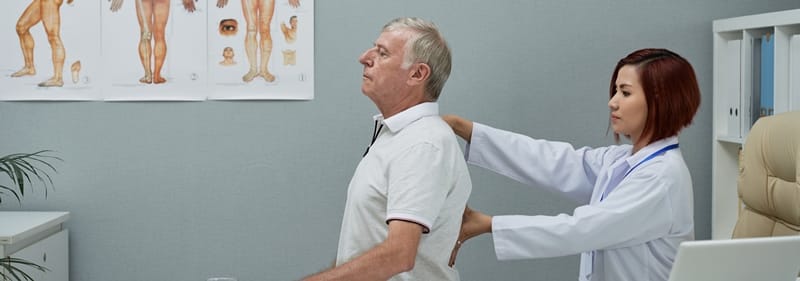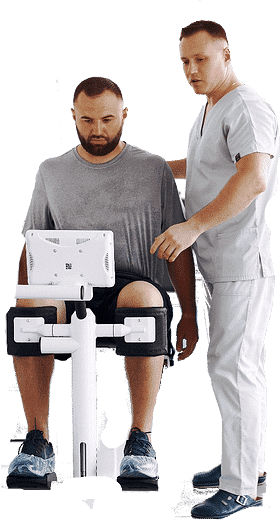Physiotherapy for Low Back Pain
Call Us: +91-9421750231, +91-7875411115.

How do Physiotherapy for Low Back Pain help?
Muscle tenancy can be very irritating. Physiotherapy for Low Back Pain treatment to get rid of such muscle tenancy or immobility is possible to heat therapy, stretching, exercises, traction, and massage. The seriousness of the problem will only determine what type of treatment procedure to be involved in the process. Physiotherapy for Low Back Pain treatments doesn’t have any kind of side effects. It’s absolutely safe, scientific, and effective.
Physiotherapy for Low Back Pain treatment not only helps a patient in escaping the pains and recovering from injuries but also saves them from such ailments in near future. Read journals or ask any healthcare professional and they will always abide by the importance of physiotherapy in treating muscle and bone injuries and pain. Believe it or not but physiotherapy treatments have also been effective in curing respiratory diseases.

Physiotherapy for Low Back Pain Treatment methods
Passive Physiotherapy method
Physiotherapy for Low Back Pain is done by use of ice packs, warm packs, ultrasound measures and electric reproductions on the patient has returned to reduce the back agony issues. This warmth treatment utilized by physios of private physiotherapy in Pune is a powerful measure that helps in warming up the muscles of the influenced zone. The ice packs utilized by the physiotherapists are a measure to calm the delicate tissues and muscles of the patient to get back torment help.
Active physiotherapy methods
Dissimilar to the inactive physiotherapy strategies received for Physiotherapy Treatment for Back Pain, dynamic techniques include the patients to perform particular extending practices which help in recuperating the lower back agony issues. The dynamic physiotherapy just focuses on practices that limit the back torment issues and furthermore helps in diminishing such severities to crawl up once more.

Prevention of Low Back Pain
-
Primary prevention:
“specific practices for the prevention of disease or mental disorders in susceptible individuals or populations. These include health promotion, including mental health; protective procedures, such as communicable disease control; and monitoring and regulation of environmental pollutants. Primary prevention is to be distinguished from secondary prevention and tertiary prevention.”
-
Secondary prevention:
the prevention of recurrences or exacerbations of Physiotherapy for Low Back Pain that already has been diagnosed. This also includes the prevention of complications or after-effects of a drug or surgical procedure.
-
Tertiary prevention:
measures aimed at providing appropriate supportive and rehabilitative services to minimize morbidity and maximize the quality of life after a long-term disease or injury is present Physiotherapy for Low Back Pain
Can A Customized Physiotherapy for Low Back Pain Help?
-
Advice and early activity
There is significant evidence to prove that encouraging early movement in the case of lower back pain is one of the most significant aspects of treatment in this condition.
-
Mobilization or Manipulative Physiotherapy for Low Back Pain
This aspect concentrates on promoting mobilization of the specific affected area. The approach of manipulative physiotherapy is used to target the specific point of pain for the purpose.
-
Specific stabilization exercises
In this aspect of physiotherapy, stress is laid on improving the strength and stability of the muscles which have been weakened due to lower back pain.
-
General exercises and stretches
A series of properly structured exercises and stretches are usually carried out in the context of the patient’s individual condition and cause of the lower back pain.
-
Ergonomic advice Physiotherapy for Low Back Pain
Since work-related hazards account for more than 65% of lower back problems, physiotherapists also concentrate on providing accurate ergonomic devices, guiding the patient on using the appropriate infrastructure at work to avoid and cure lower back pain.

COMMON Physiotherapy for Low Back Pain INCLUDE
Physiotherapy for Low Back Pain is one of the foremost widely used sorts of treatment adopted for gaining relief from low back pain. it’s utilized in both modes, as one line of treatment also as together with other treatments like massage, heat, traction, ultrasound or radio wave diathermy. The human back is essentially a highly complex system of series of interlocking elements including the vertebrae, discs, facet joints, ligaments and muscles. due to such a posh structure, an episode of back pain needs a robust physiotherapy-based program, once the essential medication course has been undertaken.
Physiotherapy for Low Back Pain TECHNIQUES ARE:
- Stretching
- Strengthening Exercise
- Muscle Energy Technique (MET
- Interferential Therapy(IFT)
- Hot Fomentation
- Traction Therapy
Physiotherapy exercises For Back Pain

Cat and Camel Exercise
The Cat-Camel Exercise is a spinal mobilization exercise that helps a person “loosen” their spine. It gets your lower back moving better. To do the Cat and Camel, the person is on their hands and knees and bends the spine up (like a cat) and then curves it downward(so your stomach hangs to the floor, like a cow).

Cobra Position Exercise
This week’s stretch is called the Cobra Stretch and it targets the hip flexors, which are the muscles along the front of the thigh and pelvis. In addition, you may also feel this stretch along the front of the torso and up into the chest! This can be a great stretch if you walk or run a lot.

Prone On Elbow
The prone on elbows into press-up stretch helps alleviate pain and nerve pressure caused by a bulging disc or a herniated disc. If you have pain or other symptoms like numbness and tingling that radiate down your leg—commonly called sciatica—this stretch may help decrease your leg symptoms.

Muscle Energy Technique (MET)
Muscle Energy Technique (MET) is a technique that was developed in 1948 by Fred Mitchell, Sr, D.O. It is a form of manual therapy, widely used in Osteopathy, that uses a muscle’s own energy in the form of gentle isometric contractions to relax the muscles via autogenic or reciprocal inhibition and lengthen the muscle.

Pelvic Bridging Exercise
A bridge exercise isolates and strengthens your gluteus (butt) muscles — the gluteus maximus, medius and minimus — and hamstrings, which are the main muscles that make up the posterior chain. It is done by lying on your back with your knees bent, feet flat on the ground and at a comfortable distance from your butt.

Spinal Twist exercise
Inhale deeply, pull your navel into your spine; as if you were being cinched at the waist. 3. Exhale, for 3 counts, twist your torso to the right. Sit Taller and increase the rotation with the next 2 breaths. You can sustain one long exhalation, or a gradual exhale on each count.

Straight Leg Raise
The straight leg exercise is often used in Physical Therapy to help patients improve the strength of their lower extremities. … The straight leg raise exercise strengthens the muscles of the upper thigh, the quadriceps, without placing any stress on the knee joint.

Bird-dog stretch
Draw your shoulder blades together. Raise your right arm and left leg, keeping your shoulders and hips parallel to the floor. Lengthen the back of your neck and tuck your chin into your chest to gaze down at the floor. Hold this position for a few seconds, then lower back down to the starting position.

Toe-touches Exercise
Reducing belly fat can be challenging because the volume of belly fat is heavily dependent on diet. But core exercises such as side planks, hollow holds, and straight leg-toe touches can help tone your abdominals — and you can do them all from the comfort of your home.

Kneeling hip flexor stretch
Kneel on your right knee.
Put your left foot on the floor with your left knee at a 90-degree angle.
Drive your hip forward. Maintaining a straight back, lean your torso forward.
Hold the position for 30 seconds.
Repeat 2 to 5 times with each leg, trying to increase your stretch each time.
FREQUENTLY ASKED QUESTIONS
Can physiotherapy cure Low Back Pain?
Physiotherapy is often a recommended treatment for various types of back pain. It may help to strengthen key muscles and reduce pain. Back pain physiotherapy includes exercises for back pain and the use of other therapies such as heat, ice or ultrasound to manage pain.
How long does it take to recover from lower back pain
In most cases of back pain your back will heal itself, and staying active and continuing with your usual activities will normally promote healing. Back pain will usually last from a few days to a few weeks. Pain that lasts longer usually clears up after about six weeks.
What is the fastest way to cure Low Back Pain?
- Exercise to Loosen Muscles. Although it may seem counterintuitive to exercise when lower back pain is causing you grief, the right kind of movement can help eliminate the discomfort. …
Use Hot/Cold Treatments. …
Stretch More. …
Get Better Shoes. …
Reduce Your Stress. …
Get Better Sleep.
WHAT MAKES YOU BETTER THAN OTHER PHYSIOTHERAPISTS?
you’ll benefit from a prompt flexible service. That includes a professional assessment and diagnosis followed by a tailor-made rehabilitation program suited to your individual needs. They have extensive experience, working both in clinics and Physiotherapists’ home visits.
What are the types of Low Back Pain?
Michael Ashburn, MD, MPH, MBA said identifies three common forms of lower back pain:
Non-specific muscular pain.
Muscle spasms.
Radicular pain.
How much does a session of Manual therapy cost?
The average cost of a physiotherapy session is 600 – 700 Rs. This is the average across Pune. The cost of a physiotherapy session can be as low as 500 Rs. as manual therapy is also included in the session you don’t need to pay any extra cost for manual therapy.
How do you know if you need physiotherapy?
If you had a particularly hard day at the gym, you would feel sore afterward. But if your pain is persistent and not getting any better, that is a sure sign that you need to see a physiotherapist. Likewise, mobility and movement are reasonably constant for a person. Sure, with age they change, but not overnight.
WHAT SHOULD I EXPECT ON FIRST VISIT ?
Our Physiotherapists will try to understand what your goals are, they will explain how they will assess you and ask for your consent before they start. After the assessment, the physiotherapist will explain what physiotherapy can help you with, how long it might take, and the expected outcome from the treatment.
